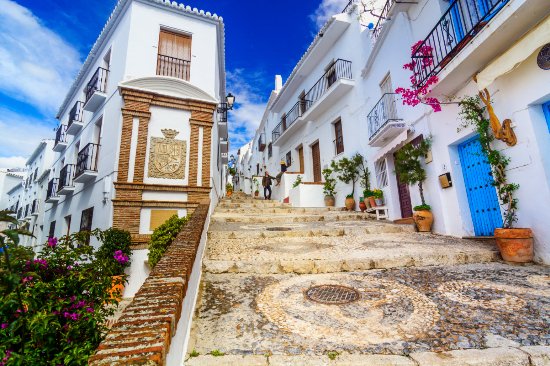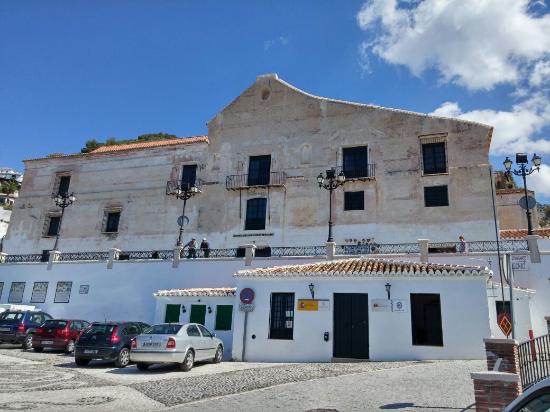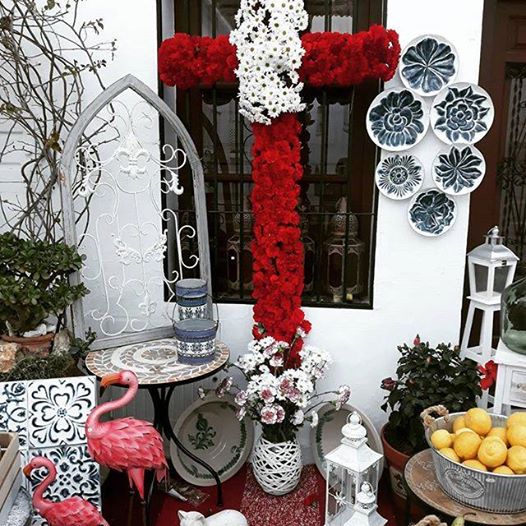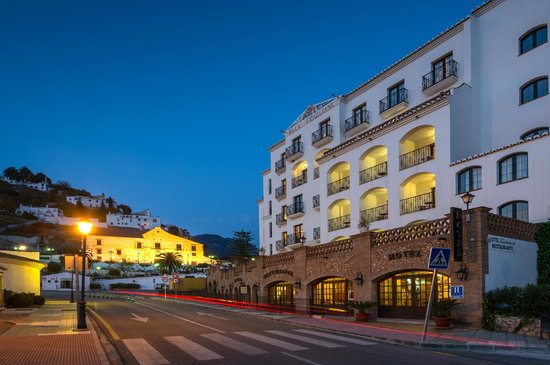Loading...
Do not worry,
we wait with you...
What to do in Frigiliana. ✅ Discover Malaga with Marbesol Malaga Guide. ⭐ Completely Free! ✅.
Facing the Mediterranean Sea on the foothills of the Almijara mountain range, some 430 m above sea level, are the whitewashed structures of the mountain village known as Frigiliana.
This enchanting 'pueblo Blanco' is just a little over 7 km north of Nerja. After your plane lands at the Malaga International Airport, which is 55 km west of Nerja, you'll need an hour on the road before you can reach the streets of Frigiliana.
Once there, you'll have to walk or get on a mule to go around, as the streets are quite narrow. Along the way, you can find peculiar fountains (ever seen one that doubles as a lamppost right in the middle of the road?), a 17th-century church, sloping streets, museums, the town hall, a honey factory and other ancient structures.
Although much of the prevailing ancient structures can be traced to the 16th to the 17th century, early civilization in the nearby regions goes as far back as 3,000 BC. The village got its name from the Romans, who moved into the territory at around 206 BC.
Frigiliana has a rich Moorish heritage, having been occupied by the Moors sometime in the early 700 AD. Christian occupants took over in 1485, with the Moors then given limited rights and subjected to oppressive actions. A rebellion ensued, ending in a bloody battle on a nearby hill known as El Fuerte in 1569 which left the Moors of La Axarquia totally defeated. Still, the presence of the Arabs has pretty much endured despite the test of time.
Interspersed with old architecture are cosy restaurants, fascinating shops, and homely hotels with breathtaking views. Basically, almost everything in town - from the street views to the surrounding landscape - are absolutely splendid photography subjects.
Just like any typical mountain village, Frigiliana is crisscrossed with inclined streets, many of which are quite steep. That is why visitors are advised to take special caution when navigating over them especially during rainy days.
Interestingly, it is during these rainy days when Frigiliana dishes, which range from flour tortillas to fresh Mediterranean fish, chorizo, and many more, and accompanied with the locally produced wine, provide the most exquisite gastronomical experience you'll ever encounter.

The man started wandering amidst the surrounding environs of Frigiliana as early as prehistoric times. This was determined after the discovery of remains, which were dated at 3,000 BC, in the Cueva de Los Murciélagos or The Bat Cave.
Frigiliana's proximity to the Higueron River, which is also near the cave, is one good reason why prehistoric nomads chose to inhabit the area. No proper village settlement took place then.
Instead, it took nearly 3,000 years before the Phoenicians and Romans became the first organized civilizations that settled in the territory. The Romans began arriving in 206 BC and are largely believed to have dubbed the place "Frexinius ana" or "the villa of Frexinius". No one knows who Frexinius really was though.
In 711 AD, the first Moors arrived and, under the leadership of Omar Ben Hafsun, eventually set up a village fortress. When the Christian forces came in 1485, the villagers surrendered peacefully. Many of them even submitted themselves to religious conversion and were subsequently known as Moriscos.
However, oppressive actions by the ruling Christians forced the Moors to start an uprising in the Alpujarra regions of Granada. Although these rebels were quickly subdued, some 7,000 Moors of La Axarquia - relying on a promise of reinforcements from Africa - retreated to El Fuerte de Frigiliana. The reinforcements never came and the Moors made their last stand there.
By orders of the governor of Velez-Malaga, the first wave of attack was carried out on May 28, 1569. The rebels were initially able to thwart the first attacks but it didn't take long for the 6,000-strong Christian forces to overwhelm the rag-tag Arabs. The rebellion was finally crushed in brutal fashion on June 11, 1569, wherein 2,000 Moors perished and the castle fortress burned to the ground.
The following year, 1570, the remaining Moors were expelled and their lands distributed to the Christians of Granada and Valencia.
Legend has it that many of those who died in the final battle actually jumped off the walls of the fortress to avoid getting captured and that bones can still be found on the surrounding hillside.
Today, no air of the violent past - not even the castle - pervades through the village. In its stead is an enchanting atmosphere that captivates visitors the very moment they step unto the tilting streets of Frigiliana.
The entire village of Frigiliana and its environs is one big museum. Along the slanting, narrow, and winding streets, you'll find structures, shops, pots, and ceramics that present an interesting mix of Christian and Moorish culture. What we have below are some of the places where you can find Frigiliana monuments and museums.
-Casa de la Cultura - You might want to start here to get hold of some general information regarding the village. Here, you'll find an archaeological museum featuring ceramic displays outlining the history of the town. The same establishment houses the local library as well as the Office of Tourism.
-San Antonio de Padua Church - This place of worship serves as the main church of the village. Although the town has managed to preserve its Moorish past, the locals are mostly Christians. In fact, this church was built on exactly the same site where a mosque once stood.
-El Ingenio - What is now known as the only operational molasses factory in Europe is actually an edifice of rich Frigiliana history. Specifically, El Ingenio has a special link to the town's social and economic past, and is demonstrated by the old accessories, documents, displays, structures and fixtures housed inside it.
-Coat of Arms - This Frigiliana monument used to be the family coat of arms of the counts who once ruled the region.
-Apero - This rectangular courtyard used to operate simultaneously with the sugar mill. It used to house a barn and a supply store.
-Cueva de Los Murcielagos - "The Bat Cave" is the site where some very old remains were found, proving that the area was already inhabited ever since prehistoric times..
-El Castillo Arabe - Actually, what you'll find here are the remains of the Arabic castle where the Moors made their last stand. Since the castle was burned to the ground, all you'll see are some rocks. According to legend, many of the defeated Moors leapt down the walls of the castle to their death during the last battle and that bones can be found in the vicinity even to this day.
-Barrio Mudejar - This place is where you'll find the most preserved Arabic structures in Malaga. Look for twelve ceramic panels depicting the Battle of the Rock, the last battle we mentioned earlier.

Frigiliana is characterized by a unique blend of Moorish and Christian cultures. Architecture and art of Moorish origins are still evident in the village. However, ever since the Moors were defeated at the Fuerte de Frigiliana in 1569 and remaining Moors driven out, practices, events and entertainment in the town have been totally Christian.
The most important events understandably take place during the Semana Santa or Holy Week, which includes the most strictly celebrated traditions in all of Christendom: Palm Sunday, Good Friday, and Easter Sunday.
On Palm Sunday, palm leaves and olive branches are blessed by the priest during the Holy Mass at the San Antonio de Padua Church. A procession also takes place wherein the leaves are paraded across the winding streets of the village.
Good Friday, which marks the death of Jesus, is the most solemn celebration of all. All throughout Frigiliana, the people put on a mournful mood and this lasts through Saturday evening.
When Easter Sunday comes, the town erupts in joyful celebration to mark the Resurrection of Jesus. Balconies are adorned with the finest quilts and rose petals are tossed to the ground below. In stark contrast to the mood of the previous Friday, Easter Sunday is full of joy.
On the month of May, the biggest celebration is the Cruces de Mayo, a tribute to the season of flowers. As the streets and plazas of Frigiliana are adourned with vibrant flowers (some fashioned into crosses), visitors are invited to take part in a feast of pork, marchochas, tortillas, arropias, and other local specialties. Young and old returning visitors never miss a treat of the delectable honey-coated cane candies.
Dances and song, which usually begin in late afternoon, continue through the night until daybreak the following day.
Every June 13 of each year, Frigiliana celebrates the feast of their patron saint, San Antonio de Padua. On that day, a figure of San Antonio de Pada is taken on a parade through the streets. The festivities, which typically last for 5 days, are highlighted by concerts, contests, and the selection of the homecoming queen. It culminates with a magnificent display of fireworks.

Frigiliana restaurants are best known for their panoramic views of the surrounding landscape, the village, and the Mediterranean sea. What we have below is a list of our most highly recommended places. They combine great food, excellent service, and enchanting ambience.
-Garden Restaurant - Sitting on a hill and overlooking the white structures of Frigiliana itself, this restaurant features outdoor tables, each shaded by an exotic parasol. Although practically all dishes on their menu taste great, we personally recommend their tapas. Don't forget to drown them with a glass of mojito. Just be sure you don't drink too much, or you might end up rolling on your way down that hill.
-Restaurante Al Fuente - Can't get enough of those tapas? Here's a nice nook where you can enjoy a different take on those Spanish delicacies. When done with your meal, have some Al Fuente coffee while you absorb the soothing atmosphere.
-Balcon de Frigiliana - A fantastic restaurant with a great view outside, Balcon de Frigiliana has an English chef who will tickle your palate in his unique Spanish way. My personal favorite is his rabo de torro.
-La Tahona - Looking for Italian cuisine in the oldest part of Frigiliana? La Tahona can serve you tapas, pizza, and beer for a distinctive gastronomical experience.
-Romantica - Since you'll always get a fantastic view of the Mediterranean up in Frigiliana, you might as well enjoy Mediterranean cuisine. And when it comes to that, Romantica is the place to be. Watch the sun go down as you round up your meal with their sticky toffee pudding.
-Adarve - Whether you go up their terrace or stay in the inner hall, the ambiance of Adarve is a cozy restaurant where you can take pleasure in their superb Andulasian gazpacho, wine and homemade ice cream.
-Ingenio - Count on Frigiliana restaurants to deliver when it comes to breathtaking views. From its terrace, Ingenio features one of the most picturesque views of the gorge and the Mediterranean.
There are certainly more restaurants in Frigiliana that have their own share of unique qualities than what can fit on this page but I'm sure you'll already have your hands full with this list.
As with all establishments in the village, the added value offered by Frigiliana hotels is the magnificent Costa del Sol climate plus the breathtaking scenery. With magnificent views of the Mediterranean Sea, the countryside, or even the village itself, it would be difficult to imagine better pleasures.
Don't expect to find large, glitzy hotels in the village. There are none. Besides, the idea is to get a feel of the old, rustic and relaxing ambience of the place. Any extremely modern structure would only ruin it all.
Most visitors come in during the day and spend the night in either Nerja or Malaga. However, if you really want to spend the night in town, here are some Frigiliana hotels you might want to check in to:
-Hotel Villa Frigiliana - Located along Calle de San Sebastian, this hotel offers complimentary buffet breakfasts, comfortable beds, free Wi-Fi, TV, a small balcony, and an on-site restaurant. If you prefer dining in another place, you can immediately find Romantica, which serves superb Mediterranean cuisine, just a few steps outside.
-Rural Hotel Almazara - This place is strategically located near the coastal town of Nerja. That means you'll be closer to supermarkets, wider streets, more commercial establishments, and the Malaga Airport.
-La Posada Morisca - With an outdoor pool, cosy bedroom, good food, and a wonderful view, this is a great place to stay. However, be forewarned that the only way to get there is by foot, on a very steep street. If you're physically fit and wouldn't mind hiking under the scorching heat of the sun, then we highly recommend the place.
-Apartamentos Rosamina - Here's one homey little hotel with an outdoor pool surrounded by a common terrace that's overlooking the countryside. For those who just can't be totally separated from their work, there's a fax/photocopying machine and free Wi-Fi.
If you're looking for more privacy, then you might want to stay in a neighbouring holiday rental villa or apartment instead. It's not that Frigiliana hotels can't offer ample privacy. It's simply that some people just want an even more homey atmosphere. If you're that kind of person, at least you now know there are other choices.

